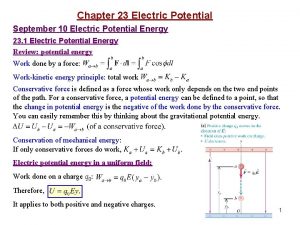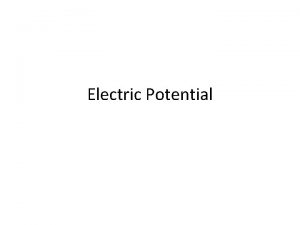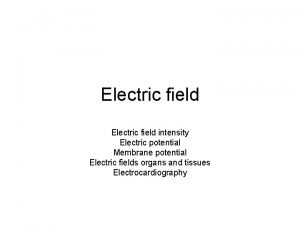Chapter 23 Electric Potential 23 3 Electric Potential










- Slides: 10

Chapter 23 Electric Potential

23 -3 Electric Potential Due to Point Charges Example 23 -7: Potential above two charges. Calculate the electric potential (a) at point A in the figure due to the two charges shown, and (b) at point B.

23 -4 Potential Due to Any Charge Distribution The potential due to an arbitrary charge distribution can be expressed as a sum or integral (if the distribution is continuous): or

23 -4 Potential Due to Any Charge Distribution Example 23 -8: Potential due to a ring of charge. A thin circular ring of radius R has a uniformly distributed charge Q. Determine the electric potential at a point P on the axis of the ring a distance x from its center.

23 -4 Potential Due to Any Charge Distribution Example 23 -9: Potential due to a charged disk. A thin flat disk, of radius R 0, has a uniformly distributed charge Q. Determine the potential at a point P on the axis of the disk, a distance x from its center.

Problem 38 38. (II) A thin rod of length 2 l is centered on the x axis as shown in Fig. 23– 31. The rod carries a uniformly distributed charge Q. Determine the potential V as a function of y for points along the y axis. Let V=0 at infinity.

23 -5 Equipotential Surfaces An equipotential is a line or surface over which the potential is constant. Electric field lines are perpendicular to equipotentials. The surface of a conductor is an equipotential.

23 -5 Equipotential Surfaces Equipotential surfaces are always perpendicular to field lines; they are always closed surfaces (unlike field lines, which begin and end on charges).

Equipotential Surfaces ~ Surfaces at same potential ~ like contours on topographic maps Lines link places at same elevation (same Ug) Lines link places at same potential (same V)

Equipotential Surfaces ~ Surfaces that have the same potential (voltage) at every point Electric Field lines are perpendicular to equipotential surfaces Potential difference between surfaces is constant Surfaces are closer where the potential is stronger Electric field always points in the direction of maximum potential DECREASE
 Electric potential energy definition
Electric potential energy definition Define electric potential and potential difference.
Define electric potential and potential difference. Electric potential and potential energy
Electric potential and potential energy Electric potential and potential difference
Electric potential and potential difference Potential due to a point charge
Potential due to a point charge V=pe/q
V=pe/q Energy in electric field
Energy in electric field Electric field electric potential
Electric field electric potential Conceptual physics chapter 33
Conceptual physics chapter 33 Chapter 23 electric potential
Chapter 23 electric potential What is electrical potential
What is electrical potential


















